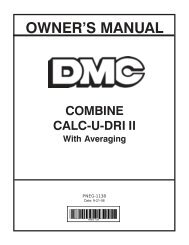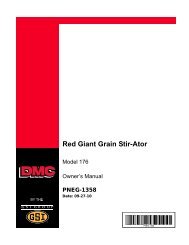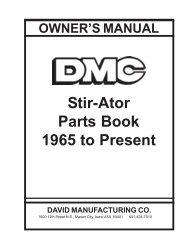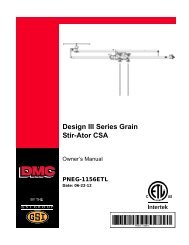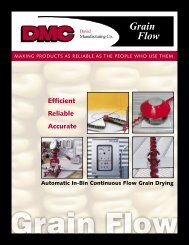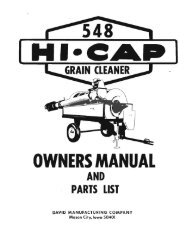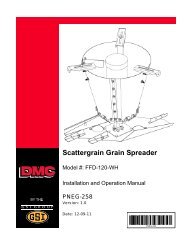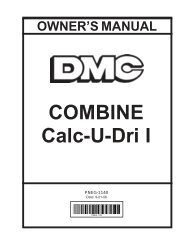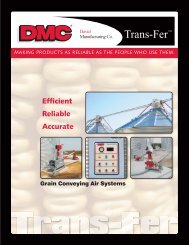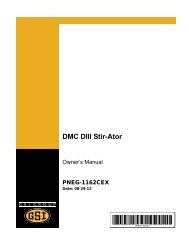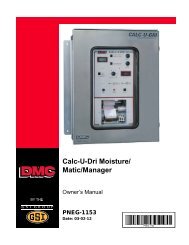Red Giant Grain Stir-Ator - David Manufacturing Co.
Red Giant Grain Stir-Ator - David Manufacturing Co.
Red Giant Grain Stir-Ator - David Manufacturing Co.
- No tags were found...
Create successful ePaper yourself
Turn your PDF publications into a flip-book with our unique Google optimized e-Paper software.
DRYING RECOMMENDATIONS<br />
To get uniform drying of grain in a bin, a uniform flow of air through the grain is required. Some<br />
of the factors affecting this air flow are: 1. <strong>Grain</strong> Cleanliness<br />
2. <strong>Grain</strong> Depth<br />
3. <strong>Grain</strong> Moisture<br />
The amount of fines and trash in the grain is best controlled by use of a grain cleaner before the grain is put<br />
in the bin. A good spreader should also be used to distribute the fines and level the grain as much as<br />
possible.<br />
Fines tend to congregate in the middle of the bin, thus leading to a restriction of the air flow in that area. So<br />
it is good to leave the center as much as 3' - 4' low to balance the air flow between the center and the bin wall.<br />
The <strong>Red</strong> <strong>Giant</strong> will tend to continually level the grain.<br />
<strong>Grain</strong> moisture of up to 26% is the optimum to dry in the bin with the <strong>Red</strong> <strong>Giant</strong>. <strong>Grain</strong> depths of up to 18 ft.<br />
can be dried in a single fill with the <strong>Red</strong> <strong>Giant</strong>. Using air only (no heat) until grain depth reaches six to eight<br />
feet, helps establish a uniform drying front. If air tubes or liners are used, the grain should be at least two feet<br />
over the top of them before heat is added to prevent channeling a large amount of the air away from the<br />
middle. A fast fill is preferred and the <strong>Red</strong> <strong>Giant</strong> can be started when the grain depth is 3' - 5'.<br />
With 27% - 30% moisture grain, some caution should be used in filling the bin above 15 feet. In this case,<br />
cleaning the grain becomes more important since more cracking is done to moist corn during combining.<br />
After the grain is dried below 25%, then additional grain can be added.<br />
Drying grain with 30% - 35% moisture is inefficient but is sometimes done out of necessity. Here again, filling<br />
twice is recommended — first cleaning the grain, then filling 10' to 15' deep, then drying down to 25%. After<br />
that, filling up to 18 ft. depth will give better results.<br />
<strong>Grain</strong> testing over 35% moisture should not be harvested for drying except under emergency conditions.<br />
Harvest damage will be excessive, and drying will be very difficult and expensive. The only course to be<br />
followed under these conditions is to fill the bin slowly and supervise constantly.<br />
The higher the moisture of the grain, the lower the starting temperature should<br />
be, to minimize wall condensation and insure highest quality of grain.<br />
66 PNEG-1358 <strong>Red</strong> <strong>Giant</strong> <strong>Stir</strong>-<strong>Ator</strong>



